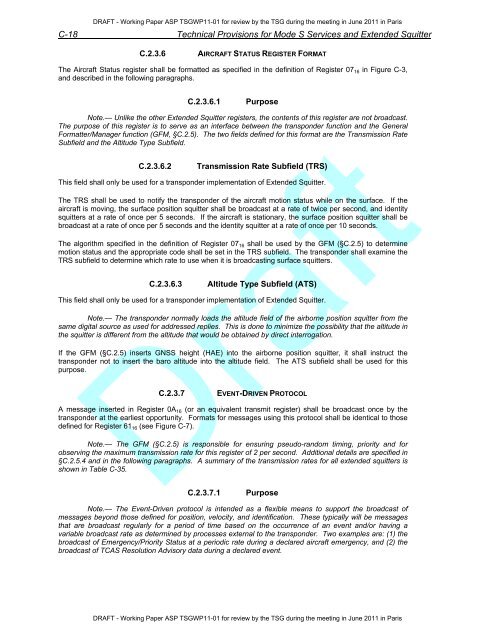Technical Provisions for Mode S Services and Extended Squitter
Technical Provisions for Mode S Services and Extended Squitter
Technical Provisions for Mode S Services and Extended Squitter
Create successful ePaper yourself
Turn your PDF publications into a flip-book with our unique Google optimized e-Paper software.
DRAFT - Working Paper ASP TSGWP11-01 <strong>for</strong> review by the TSG during the meeting in June 2011 in Paris<br />
C-18 <strong>Technical</strong> <strong>Provisions</strong> <strong>for</strong> <strong>Mode</strong> S <strong>Services</strong> <strong>and</strong> <strong>Extended</strong> <strong>Squitter</strong><br />
C.2.3.6 AIRCRAFT STATUS REGISTER FORMAT<br />
The Aircraft Status register shall be <strong>for</strong>matted as specified in the definition of Register 07 16 in Figure C-3,<br />
<strong>and</strong> described in the following paragraphs.<br />
C.2.3.6.1 Purpose<br />
Note.— Unlike the other <strong>Extended</strong> <strong>Squitter</strong> registers, the contents of this register are not broadcast.<br />
The purpose of this register is to serve as an interface between the transponder function <strong>and</strong> the General<br />
Formatter/Manager function (GFM, §C.2.5). The two fields defined <strong>for</strong> this <strong>for</strong>mat are the Transmission Rate<br />
Subfield <strong>and</strong> the Altitude Type Subfield.<br />
C.2.3.6.2 Transmission Rate Subfield (TRS)<br />
This field shall only be used <strong>for</strong> a transponder implementation of <strong>Extended</strong> <strong>Squitter</strong>.<br />
The TRS shall be used to notify the transponder of the aircraft motion status while on the surface. If the<br />
aircraft is moving, the surface position squitter shall be broadcast at a rate of twice per second, <strong>and</strong> identity<br />
squitters at a rate of once per 5 seconds. If the aircraft is stationary, the surface position squitter shall be<br />
broadcast at a rate of once per 5 seconds <strong>and</strong> the identity squitter at a rate of once per 10 seconds.<br />
The algorithm specified in the definition of Register 0716 shall be used by the GFM (§C.2.5) to determine<br />
motion status <strong>and</strong> the appropriate code shall be set in the TRS subfield. The transponder shall examine the<br />
TRS subfield to determine which rate to use when it is broadcasting surface squitters.<br />
C.2.3.6.3 Altitude Type Subfield (ATS)<br />
This field shall only be used <strong>for</strong> a transponder implementation of <strong>Extended</strong> <strong>Squitter</strong>.<br />
Note.— The transponder normally loads the altitude field of the airborne position squitter from the<br />
same digital source as used <strong>for</strong> addressed replies. This is done to minimize the possibility that the altitude in<br />
the squitter is different from the altitude that would be obtained by direct interrogation.<br />
If the GFM (§C.2.5) inserts GNSS height (HAE) into the airborne position squitter, it shall instruct the<br />
transponder not to insert the baro altitude into the altitude field. The ATS subfield shall be used <strong>for</strong> this<br />
purpose.<br />
Draft<br />
C.2.3.7 EVENT-DRIVEN PROTOCOL<br />
A message inserted in Register 0A16 (or an equivalent transmit register) shall be broadcast once by the<br />
transponder at the earliest opportunity. Formats <strong>for</strong> messages using this protocol shall be identical to those<br />
defined <strong>for</strong> Register 6116 (see Figure C-7).<br />
Note.— The GFM (§C.2.5) is responsible <strong>for</strong> ensuring pseudo-r<strong>and</strong>om timing, priority <strong>and</strong> <strong>for</strong><br />
observing the maximum transmission rate <strong>for</strong> this register of 2 per second. Additional details are specified in<br />
§C.2.5.4 <strong>and</strong> in the following paragraphs. A summary of the transmission rates <strong>for</strong> all extended squitters is<br />
shown in Table C-35.<br />
C.2.3.7.1 Purpose<br />
Note.— The Event-Driven protocol is intended as a flexible means to support the broadcast of<br />
messages beyond those defined <strong>for</strong> position, velocity, <strong>and</strong> identification. These typically will be messages<br />
that are broadcast regularly <strong>for</strong> a period of time based on the occurrence of an event <strong>and</strong>/or having a<br />
variable broadcast rate as determined by processes external to the transponder. Two examples are: (1) the<br />
broadcast of Emergency/Priority Status at a periodic rate during a declared aircraft emergency, <strong>and</strong> (2) the<br />
broadcast of TCAS Resolution Advisory data during a declared event.<br />
DRAFT - Working Paper ASP TSGWP11-01 <strong>for</strong> review by the TSG during the meeting in June 2011 in Paris
















